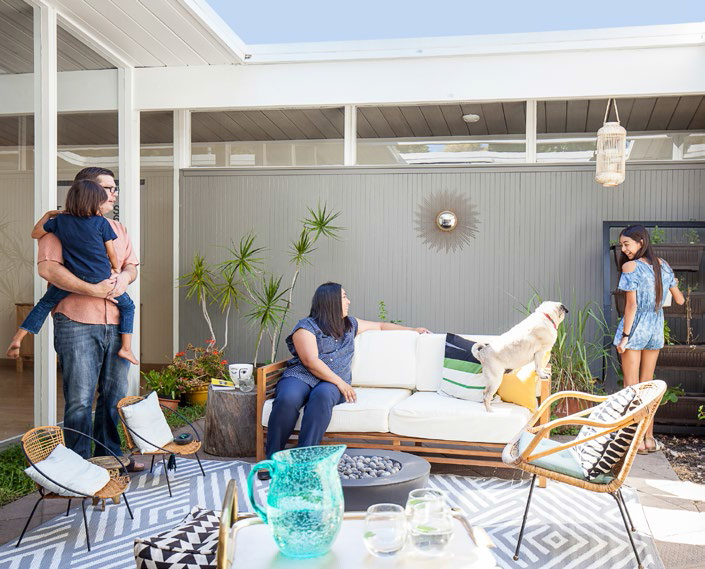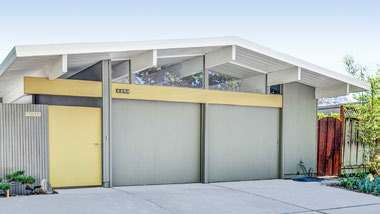Razing the Roof - Page 4
 |
|
|
 |
 |
|
|
 |
|
|
 |
|
|
Schools, parks, and playgrounds are all a short walk away. Parents gather in driveways at night to sip wine while their kids play on the sidewalk and in the streets, they say.
Just to show how little things change—in a good way!—Rosa Maria Garfunkel, Ella's mother, had an experience similar to that of Veronique and Eric when her husband scoped out Fairglen in 1998.
He said, 'You know what? There are kids playing in the street!' And that did it for my husband. A neighborhood where kids could play in the street!"
"One of the primary things I like about the neighborhood is that it really is a neighborhood, and that's what you don't find a lot around anymore," says Jeff Stowe, a resident since 1995. "And whether you're a fan of mid-century, whether you're a full-blown mid-century architecture fan, it doesn't matter. The fact that we live in these houses brings us together."
One social activity that brings people together while having nothing to do with modernism is the dice game Bunco. Women get together regularly at each other's homes, several say.
"They're pretty fun," Melissa Leman says. "You get to go to everybody's house and meet people in the neighborhood."
If you're wondering why the neighborhood united so easily behind what could have been a divisive issue like placement on the National Register, Bunco games may not be the answer.
But Bunco didn't hurt. Clearly, the friendships and mutual understandings that developed in Fairglen over the past few decades made the task much easier.
Peter Hurd, a resident since 1972 and one of the Register project organizers, emphasizes that the effort began as a groundswell from the community, not from some tight cabal. Veronique Bourdeau recalls that she was one of the neighbors who began saying "maybe we should start something like that" on the social platform Nextdoor.
"We wanted to have the younger generation, along with people who have been in the neighborhood for 50-plus years [behind the effort]," Veronique says. "We were all agreeing on the same things. It kind of came together really organically, I would say."
Jenny Quigley, who moved to Fairglen from the Eichler National Register neighborhood of Greenmeadow five years ago, spread the word about the Register effort to her Fairglen neighbors. She remembers the early fears: "Are you going to tell me that I can't have an addition to my house? Are you going to tell me what color to paint my house? Are you going to tell me I can't put a second story on my house?"
Her response? "[Being on] the National Register doesn't allow us to do any of that."
Xavier Cohen recalls how Register proponents dispelled these fears, by arguing the National Register wouldn't order people to do anything, but merely provide "guidance."
"That was the key—when people shifted, when people were saying [that] it helps you by providing guidance," he says. "Guidance versus control, exactly."
Originally, folks thought they would include the other Eichler clusters in the Register nomination. But, says Chris Sanders, who lives in the nearby Hudson cluster, it would have been hard to include a 'satellite' tract.
But that doesn't mean the Hudson Eichlers won't hit the Register too.
"I am working with Bill [Pfahnl] to do the same process here," Chris says, adding that the Hudson Eichler cluster is "largely intact."
Being on the National Register does not impose any rules about what people can do with their homes. Design guidelines or enforceable regulations are steps that can be imposed locally by the city—but the folks behind the National Register effort take a more relaxed approach.
There are no plans now to seek local design guidelines or regulations. But National Register backers think Fairglen's current status is already paying off, simply by emphasizing the importance of the homes and the tract.
Being on the Register, Bill Pfahnl says, should discourage people who want to come to Fairglen and consider ripping down or ill-treating Eichlers—while attracting buyers who love the homes.
About Eichler homes, he says, "You either get it, or you don't."
• The main section of Fairglen (approximately 218 Eichlers) is bordered by Andalusia Way, Booksin Avenue, Curtner Avenue, and Briarwood Drive. This is the tract named to the National Register. About 90 Eichlers can be found to the west, bordered by Frobisher Way, Raleigh Drive, Dumbarton Avenue, and Hudson Drive. The approximately 30 'Dry Creek Eichlers' are found on Margot Place and Adele Place, off Dry Creek Road.
Photography: Sabrina Huang, Xavier Cohen
- « first
- ‹ previous
- 1
- 2
- 3
- 4




